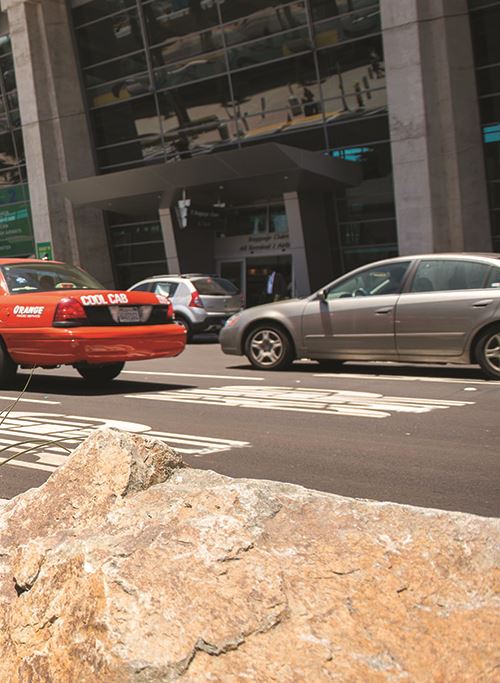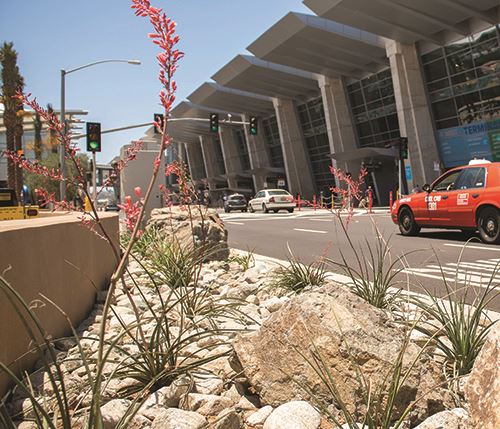Airport operators short on usable real estate might want to check out what’s happening at San Diego International (SAN), an airport that is boxed in by both land and water. Using a digital system to dispatch taxis has allowed SAN to significantly decrease the land needed for its taxi hold lot and freed up valuable space for other uses.
Airport operators short on usable real estate might want to check out what’s happening at San Diego International (SAN), an airport that is boxed in by both land and water. Using a digital system to dispatch taxis has allowed SAN to significantly decrease the land needed for its taxi hold lot and freed up valuable space for other uses.
 “We’ve had about 75% decrease in hold lot usage,” reports Mike Anderson, manager of ground transportation at SAN, a 661-acre airport with precious little space. He credits the significant shift to an app-based system SAN implemented in mid-January for $25,000.
“We’ve had about 75% decrease in hold lot usage,” reports Mike Anderson, manager of ground transportation at SAN, a 661-acre airport with precious little space. He credits the significant shift to an app-based system SAN implemented in mid-January for $25,000.
“The eDispatch system allowed us to move our taxi operation from our existing lot, which had a capacity of 275 vehicles, down to a lot with 70 positions,” Anderson explains. “This is important to us, given the limited space we have and have access to, being in a downtown environment.”
|
facts&figures Project: Digital System for Dispatching Taxis Location: San Diego Int’l Airport Airport Owner/Operator: San Diego County Regional Airport Authority 2021 Passenger Volume: 15.6 million Technology: eDispatch from GateKeeper Systems Cost: $25,000 plus $2,220/year for software licensing & support fees Installation: mid-January 2022 Format: Taxis use app to join virtual dispatch queues; airport texts drivers when it is their turn to pick up passengers Key Benefits: Less land & maintenance needed for taxi hold lot; less traffic; fewer emissions because there aren’t as many idling taxies in the hold lot; virtual queues can be unlimited in length; increased flexibility to move hold lot during construction |
The new dispatch strategy, from GateKeeper Systems, also has virtually eliminated traffic backups that plagued SAN when too many of its 370 registered taxi drivers converged on the airport at once.
“The lot couldn’t fit all the taxis choosing to operate at one time,” Anderson recalls. “On peak days, we’d have taxi drivers who wanted to enter the lot, but couldn’t, so traffic would back up onto the entry roadways.
“We can’t have that happen, so we’d immediately dispatch traffic enforcement to divert those drivers elsewhere,” he adds. “But then they couldn’t get into the queue.”
With the airport’s new digital system, taxi operators can get placed into the virtual dispatch queue without driving into the airport lot. This allows them to continue earning off-site fares while waiting for their respective turns at SAN—and reduces associated congestion in the hold lot and on airport roadways.
Beyond an add-on module-implementation fee of $25,000 for its specific configuration of the eDispatch system, SAN will pay an annual software licensing and support fee of $2,220. That amounts to about $6 per registered taxi per year, Anderson notes.
Implementation and ongoing support costs vary widely, depending on an airport’s size and configuration, and what features/functionality officials want, says Brian Richardson, president of GateKeeper Systems.
There’s an App for That
Here’s how the digital dispatching system works: When taxi drivers want to enter the dispatch queue, they use a web-based app on their cellphones to reserve a spot. The system then dispatches taxis in the order the requests are received.
 “They can be anywhere and still join the queue,” Richardson notes. “Because they don’t physically have to be in the hold lot, they can keep operating and earning money while they work their way to the top of the queue.
“They can be anywhere and still join the queue,” Richardson notes. “Because they don’t physically have to be in the hold lot, they can keep operating and earning money while they work their way to the top of the queue.
“When they reach the top of the virtual queue, they get a text notifying them that they need to be at the airport within a certain time.”
Airports using eDispatch determine how much time to give taxi drivers to report to the airport. At SAN, for example, drivers must report within 20 minutes after they’re notified. They then can proceed directly to the terminal they were dispatched to. If drivers don’t arrive at the airport on time, officials can choose from several options, including eliminating them from the queue altogether or dropping them down a certain number of spaces.
Because SAN’s dispatch queues are virtual, there is no limit to how long they can be. Taxi lines are no longer constrained by the physical space available at the airport, Anderson says.
Operational Efficiency & Flexibility
Previously, SAN used a dispatch system that relied on radio-frequency identification (RFID) tags. As each taxi entered the hold lot, the system “read” its tag and automatically placed the vehicle in a dispatch line.
Drivers waited in the lot until it was their turn and an electronic dispatch board indicated which terminal they should report to. Occasionally, intermittent power disruptions rendered the dispatch board inoperable and caused operational hiccups.
“This is a much more robust system that won’t be subject to power outages,” Anderson contrasts.
The dispatch board is now a thing of the past, but taxis still need RFID tags because the airport uses them to track traffic and collect trip fees. Furthermore, SAN still posts customer-service representatives at the curbside areas to assist passengers and make sure taxi operators are following the rules.
Eliminating the need for a fixed dispatch board makes it easier for SAN to move its taxi lot—something that has been particularly important during a major building project. The $3.4 billion improvement program, which is scheduled to continue into 2028, includes replacing Terminal 1 with a structure that includes 30 additional gates, plus associated roadway improvements.
“We need to be extremely flexible with the hold lot’s location,” emphasizes Anderson. “With all the construction going on right now, real estate at the airport has become even more scarce.
“Because we don’t have a lot of space here, we have to do the construction in phases. So we’ll need to move the hold lot around to accommodate the construction work. That would’ve been more difficult to do with a fixed board.”
The smaller, more flexible hold lot also costs less to maintain, adds Anderson. Because the lot doesn’t receive as much traffic, its portable restrooms now need servicing once a day instead of twice, and the interval for trash collection was extended.

Pre-Launch Prep Pays Off
The airport’s digital dispatch system came online Jan. 12. Richardson reports that software installation took about an hour, though more time was required up front to determine its specific configurations.
Weeks before the changeover, SAN held two videoconferences for taxi drivers to explain how the new system works. The week before eDispatch went live, the airport stationed staffers at the hold lot to review the process and answer questions in person.
Anderson reports that taxi drivers have thoroughly embraced the new system.
“They love it,” he says, noting that several drivers have asked him why the airport didn’t switch to it years ago. “They can stage themselves at other venues, such as hotels or special events, and keep working until their turn in line arrives. It allows them to use their time and their vehicles much more efficiently.”
While the new system greatly improves operations for the airport and taxi drivers, it does not completely eliminate the need for a hold lot.
“We’ll always need a hold lot,” says Anderson. “But it will be a lot smaller than before. That’s significant, because we’re one of busiest airports in the United States (15.6 million passengers in 2021) with one of the smallest footprints (661 acres).”

Technology Trend
Two other major U.S. airports also use the eDispatch system: Philadelphia International Airport (PHL) and Raleigh-Durham International Airport (RDU).
Given the positive response at all three airports, Richardson feels that taxi dispatching is a process that’s ready for technological disruption. Officials at SAN are certainly pleased with the benefits—decreased emissions from idling taxis, less traffic congestion and, of course, freeing up valuable real estate formerly occupied by hold lots.
Does Anderson have any advice for other airports about digital dispatching?
“I wish we would have implemented it a lot sooner; so I’d advise them to check it out,” he says. “We’re very happy with the system.”



